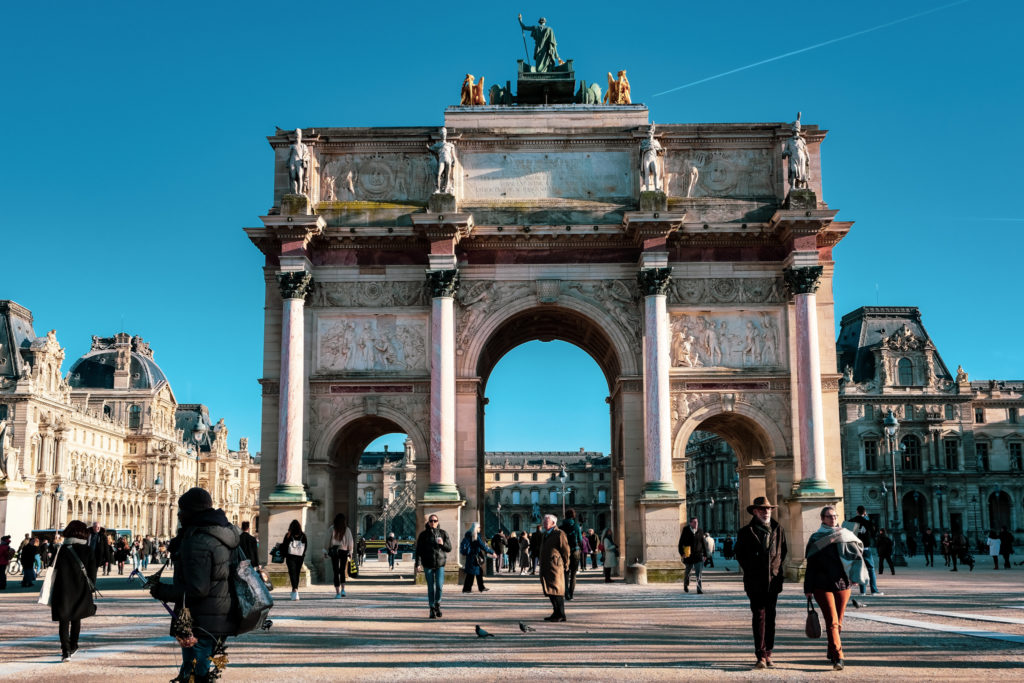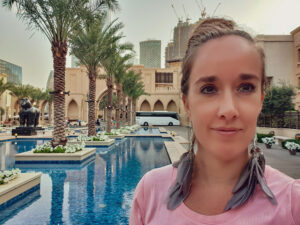Paris is renowned for its numerous iconic landmarks. The French capital has many impressive museums, grand palaces, picturesque squares, historic churches and other significant structures that have become famous landmarks. These monuments are a key attraction for visitors. Each monument narrates a unique story, whether it’s historical, religious, national, human-centric, or a reflection of hope for the future.
For over two millennia, Paris has stood as a cultural powerhouse, continually reinventing itself, particularly during the Renaissance period. The city itself is a living museum displaying centuries of architecture and arts around the city.
Table of Contents
Musée du Louvre
In the 16th century Francis I started to expend the chateau into a renaissance palace. In 1610 the construction was continued by Henry IV who completed the long gallery along the Seine. This gallery linked the Louvre with the Tuileries Palace. Later on, Louis XIV enlarged the palace with several wings and a grand monumental entrance. In the end, the palace was incomplete. When the court moved to the new Palace of Versailles the Louvre was left behind to a few artists and opportunists. After the French Revolution the palace was turned into a museum. It mainly showed the royal collections.
The Louvre Museum as we know it today was finished by the president Mitterrand in 1993. The glass pyramid is the main entrance of the museum and gives light to the underground foyer.

Arc du Carrousel du Louvre
Arc du Carrousel du Louvre was built by Napoleon. This arc used to be the formal gateway to the Tuileries Palace, which was destroyed in 1871 by a fire. Because the palace was destroyed the arc became the first landmark of the great historical axes of Paris. The axes continue further along by the arches at Place de l’Etoile and La Défense, the business district of Paris.
Grand Palais
The Grand Palais was built between 1897 and 1900 for the World Fair. The building has stone façades but the roof is entirely built out of metal and glass. In the middle of the roof is a glass dome. The Grand Palais houses many art exhibitions and is often used for trade fairs, fashion shows and other large events. In 1993 the Grand Palais was closed to the public and reopened in 2007 after a major renovation of the roof. The glass structure of the roof is replaced with modern and stronger panels.

Petit Palais
Compared to the Grand Palais and other palaces in the city, Petit Palais is relatively small. It houses the Fine Arts Museum and is located across from the Grand Palais. The admission is free and has a magnificent courtyard. The courtyard has a symmetrical composition, detailed decoration and a half circle gallery. The floor of the gallery is covered with mosaic patterns. The courtyard is a perfect place to relax especially when the sun is out.

Pont-Neuf
The oldest bridge in Paris is Pont-Neuf and honours the memory of Henry IV. The King created this bridge. It was opened in 1607 to make it easier for traffic to go through the neighbourhood of Ile de la Cité. The bridge was a great success. It was the first stone bridge without any houses and so it provided a wider view of the Seine river. The bridge was uneasily wide at that time. There were sidewalks and half circle “enclaves” to protect pedestrians from riding carriages and horses.
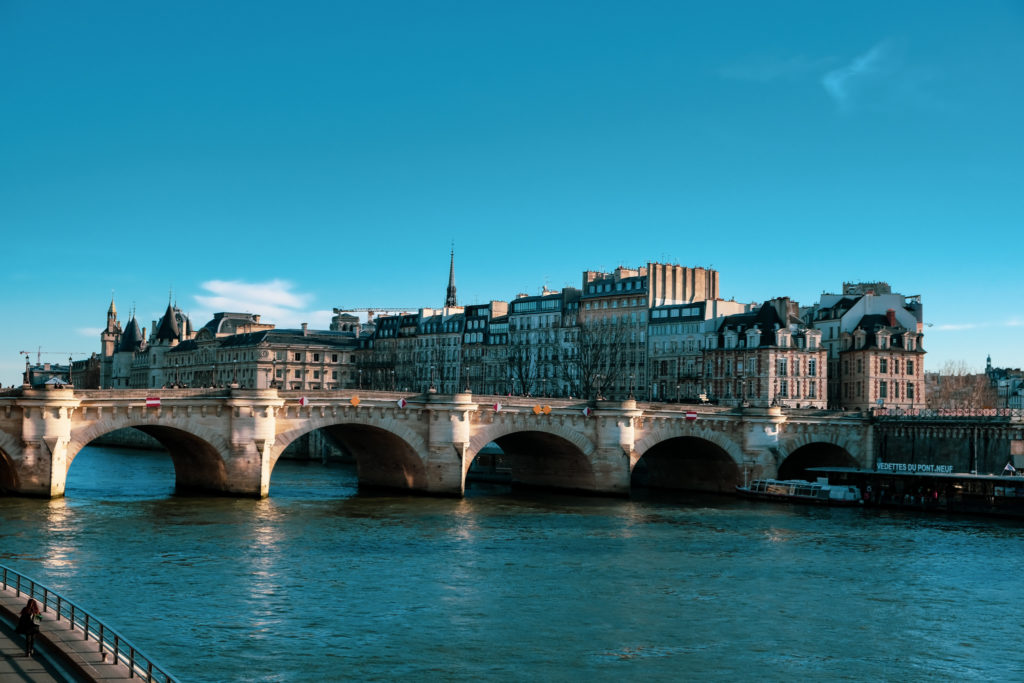
The Eiffel tower
One of the popular landmarks in the city is the Eiffel Tower. This metal structure was built for the World Fair in 1889. The construction of the tower faced fierce opposition from the cities artistic elite. Two decades later it was almost destroyed and only saved to be of use as a radio tower. The Eiffel Tower was named after the architect, Gustave Eiffel.
Three levels are open to the public. The first floor is always open. The higher levels are closed when the wind is too heavy. It is possible to take a lift to the second and third floor. You can take the stairs if you are in the mood for a good cardio work-out! Around the Eiffel Tower are the Jardins du Trocadéro. When weather permits you can go for a picnic in this park or just walk around the fountains and statue garden.
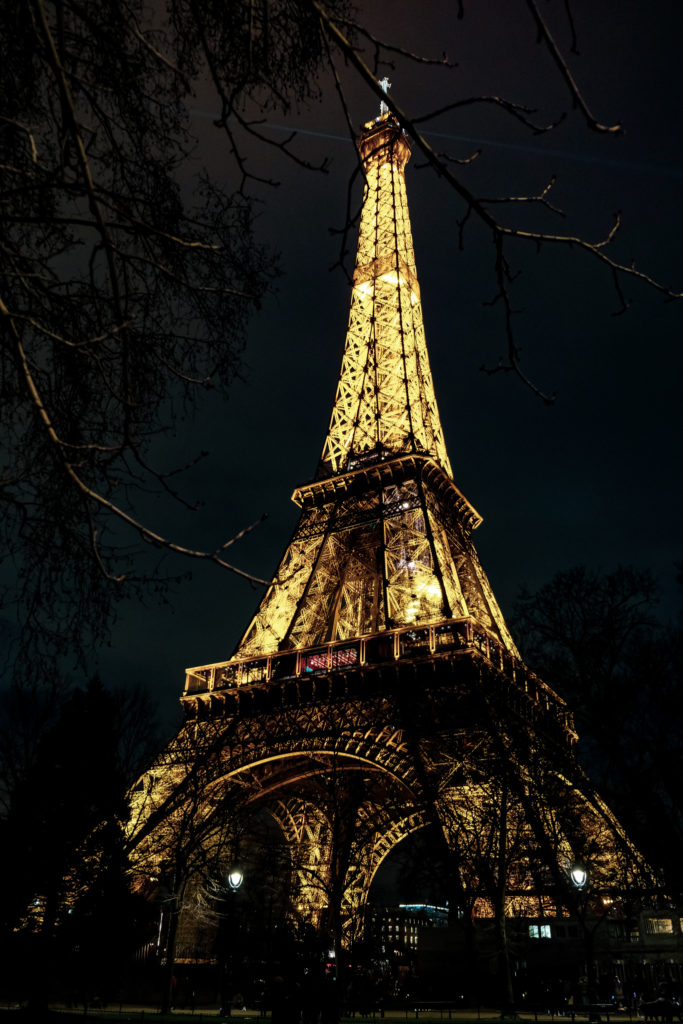
Champs- Élysées
The Avenue des Champs- Élysées is a famous street in the 8th arrondissement in Paris. The street is 2km long and located between Place de la Concorde and the Arc de Triomphe. It’s well known because of the many cafes, luxury shops, theatres and restaurants. Every year the Tour de France finishes in this street.
The avenue used to be surrounded by gardens in 1667 and were an extension of the Tuileries Gardens. During the Hundred Days War, the British and Russian armies used the trees along the promenade as firewood. After the downfall of Napoleon and the French monarchy new trees had to be planted. In 1860 merchants joined together to promote commerce along the avenue and transformed the avenue as we know it today.
The avenue has seen many military parades. Every year on July 14th, Bastille Day, the largest military parade in Europe is held at the Champs- Élysées. Bastille Day is the most important National holiday in France. Every year since 1880, the French Republic has celebrated the storming of the Bastille in Paris which is symbolic for the start of the French Revolution.
Arc de Triomphe
The Arc de Triomphe is situated in the middle of a large traffic roundabout. The arch was commissioned in 1806 by Napoleon to honour his victories. Later on he started losing battles and the arc remained unfinished until 1836. Underneath the arch is the tomb of an Unknown Soldier, who was fighting for France in World War I. From the viewing platform you have a stunning view of Paris, the avenues, Avenue Foch, Avenue des Champs Élysées and the 3300- year old pink granite obelisk from Egypt at Place de la Concorde.
Cathedral Notre-Dame
The construction of the Notre-Dame started in the 12th century and was finished in 1345. The Cathedral is located on an island, Ile de la Cité and one of the oldest gothic cathedrals. During the centuries parts were destroyed or reconstructed. In a huge fire in 2019 the attic, roof and other parts were destroyed.
During the French Revolution the cathedral was used as a warehouse and damaged. Victor Hugo wrote a novel in 1831, Notre-Dame de Paris, which became very popular. Because of Hugo’s novel, the cathedral was saved an restored.
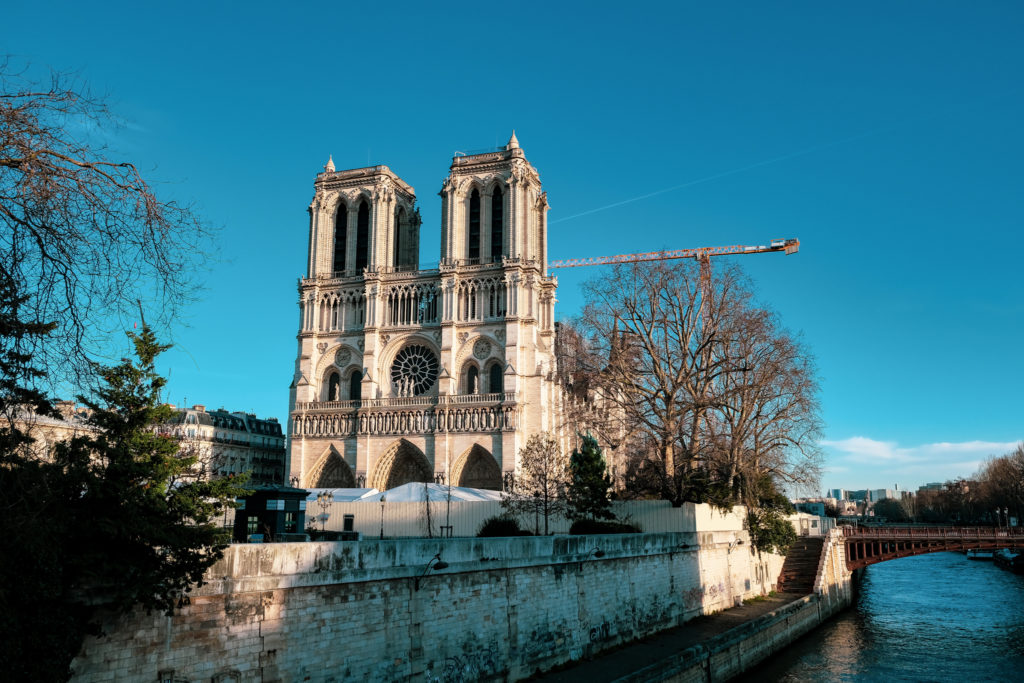
Jardin du Luxembourg
The Luxembourg gardens are located in the 6th arrondissement. In 1612 Marie de Medici created the garden when she started the construction of the Luxembourg Palace. Today the garden is owned by the French Senate, which reside in the Palace. The garden is 23 hectares and known for the promenades, flowers, the Medici Fountain and the moveable chairs. The garden has more than a hundred monuments, statues and fountains. Surrounding the central green space and basin are 20 statues of French Queens and famous women.
The Medici Fountain was built in 1630 by Marie de Medici. She was the widow of King Louis XIII. She was from Florence and the designer was a Florentine fountain maker and hydraulic engineer. The form of the fountain is a grotto (cave) and a popular feature in this Italian Renaissance garden. The fountain fell into decay in the 18th century but was restored and moved to it’s current location at the command of Napoleon Bonaparte.
French Novels about Jardin du Luxembourg
The gardens became popular after the famous love story between Pontmercy and Cosette, from Victor Hugo’s novel Les Misérables. Jardin du Luxembourg is where the two characters first meet. Other famous writers uses these gardens in their work, like Henry James and William Faulkner.
Les Catacombes
Maybe a bit morbit but a visit to this underground cemetery is an experience you never forget. The Catacombes is one of the three underground cemeteries in Paris and constructed in the late 18th century to solve the problem of overflowing cemeteries. The cold and windy tunnels are covered with bones, skulls and dust of more than 6 million people.
Only a small section of the catacombs is open to the public. There are approximately 140 miles of tunnels that form a maze beneath the streets of Paris. Follow the signs and don’t wonder off. In 2017 teenagers got lost in the tunnels and spend three days down there before rescue dogs found them.
Sacré- Cœur Basilica
The Sacré-Cœur was a controversial project in the 19th century. A few intellectuals wanted to proof the vitality and strength of Christianity towards the secular representatives of the new republic. They received private donations for the construction costs but ran out of money before any above ground structure was visible. Despite being controversial, the project was passed by parliamentarians and work started in 1876. The basilica is built on a hill and the ground was unstable and filled with rocks and stones. To built a solid foundation a deep shaft had to be made. Construction continued for more than 40 years.
The original plans of the Sacré-Cœur changed many times and the monument has romanesque arches as well as Byzantine coloured-glass windows. Remarkable is the stone they used to built the basilica. When it’s raining the stone becomes white again.
The Savoyarde is the 19- ton bell and therefor the heaviest bell in Paris. The basilica was consecrated in 1919 and popular for tourists and pilgrims. Knowaday it’s a famous well visited monumental highlight in Paris.
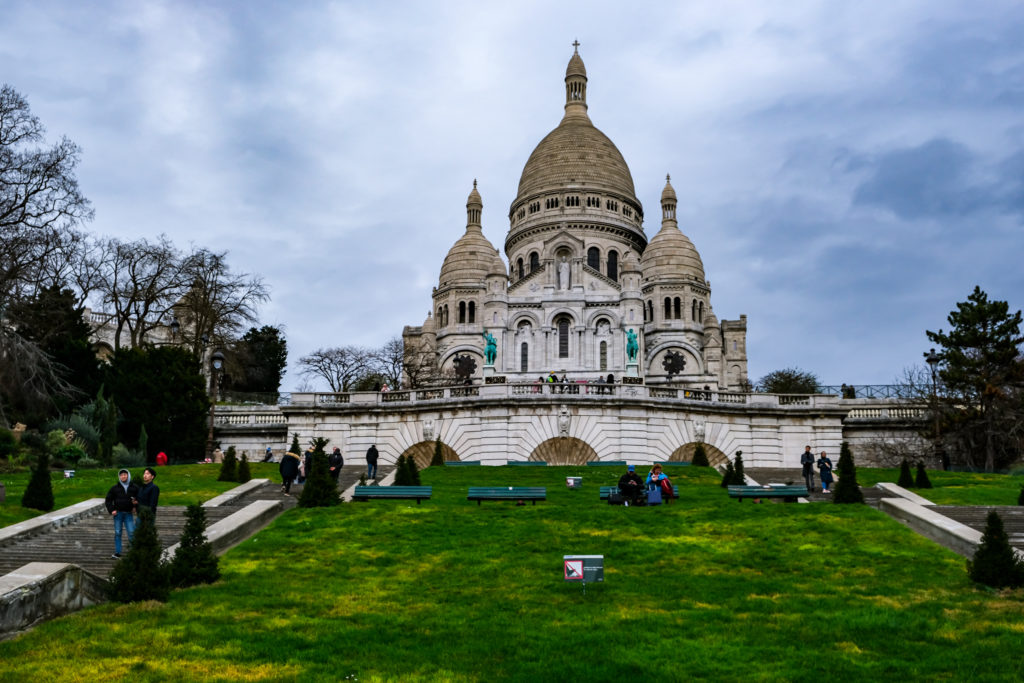
Cimetière du Père Lachaise
The Père Lachaise cemetery is located in the 20th arrondissement. It was the first garden like cemetery in Paris in the 19th century. It’s also the largest cemetery in the city with 44 hectares of land. The cities graveyards filled and several new large cemeteries were built in the outside arrondissements of the city. The cemetery was opened in 1804 and named after the confessor to Louis XIV.
At the time of opening the cemetery was considered to be too far away from the city. The Roman Catholics refused to be buried here for the reason that the cemetery was not blessed by the Church. As a result the cemetery counted only 13 graves in the first years of the 19th century. In 1804 the administrators moved the remains of Jean de La Fontaine and Molière with theatrical display to this new cemetery. Thirteen years later two other famous Parisian were moved to the cemetery. All of a sudden people wanted to be buried among the famous citizens. In 1830 the Père Lachaise cemetery counted over 33.000 graves and was expanded five times. Today there are more than 1 million people buried here. Even more if you count the cremated remains in the columbarium.

Château de Versailles
The Palace of Versailles is located circa 21km southwest of Paris. The palace is a historical monument and on the UNESCO World Heritage list. In 1623 Versailles used to be a small hunting lodge of King Louis XIV. His first amorous adventures with Mademoiselle de la Valliére were here. Versailles reminded him of those happy days. During the revolts in Paris he wanted to get away and the King was inspired to expand the domain and palace in 1662. Ten thousands workers were needed to built the long canals and aqueducts to supply the gardens and fountains with water. New factories were built to produce the numerous items of furniture and decoration for the expanding palace.
In 1682 the King decided that Versailles would be his permanent residence and also for his government. During later centuries more construction and expension followed. A famous example is the Hall of Mirrows where silver furniture was displayed. Later on a chapel and opera house were also added to the palace.
In The World’s Jungle – Travel posts
Interested in articles about European architecture? Read the monumental highlights in Antwerp or explore the monuments in the medieval city of Krakow. I have written a Beginners guide to Architecture about the historicial European architectural styles, starting at Ancient Egypt until the Neoclassicism.
You may also like to know more anout other European destinations. Check out the idyllic island of Texel in the Netherlands. Go on a virtual tour in Stockholm and Barcelona or explore the Wieliczka Salt mines in Poland.
In The World’s Jungle – Personal Travel Guide
Interested to know more about In The World’s Jungle and the articles you can find here? Read more on the About page or get to know Adriana. I can help you planning your trip, find unique places to stay, set-up an itinerary and make other necessary arrangements. Feel free to contact me and let me know how I can help you. Check the Service page to learn more.
